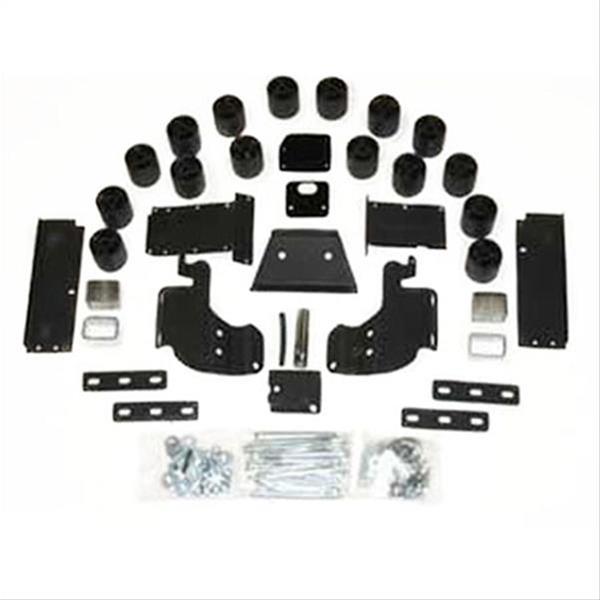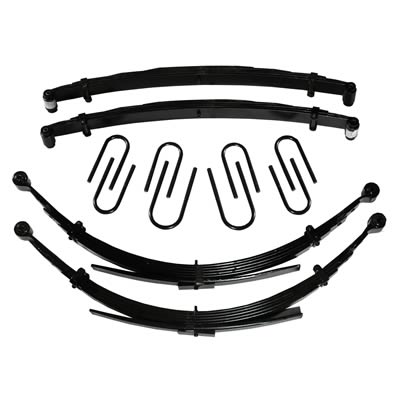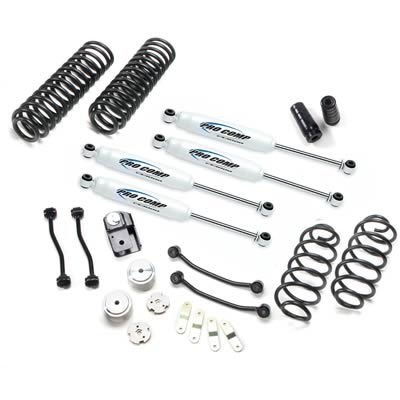One of the many appealing things about owning a truck is the sense of unlimited possibilities. You can haul stuff. You can tow boats, campers, and trailers. You can plow snow. And above all, you can go just about anywhere in a pickup with the right lift kit.
We don’t necessarily think we need to sell you on the benefits of an aftermarket lift kit.
We do, however, want to educate you on how to choose the right one for your truck, so you can maximize those benefits. Depending on the kit, you can get anywhere from a 1/2-inch of lift to a 6 inches and beyond. You can choose a body lift, suspension lift, or leveling kit from a wide variety of manufacturers.
So which one is for you?
How to Choose a Lift Kit
Choosing the right kit comes down to a few key things:
- Vehicle type
- Vehicle purpose
- Desired tire size
- Your budget
Will your truck see extended duty on the trail? Do you want to maintain a good ride and comfort for commuting? Do you haul a lot of stuff for your job or friends? Are you just looking to stuff a larger set of tires underneath for effect?
Honest answers to these questions will help you make the right choice.
Body Lift Kits
A body lift kit generally consists of a set of spacers that separates the frame from the truck’s suspension. This lifts the body higher, but the chassis and suspension remain at the same height in relation to the ground so there’s no additional ground clearance. Although limited in the amount of lift they can provide, body lift kits offer that lifted look, accept larger off-road tires (to a point), and have less effect on the drivability and comfort of your ride.
Advantages
- Less expensive than full suspension lifts
- Less effect on ride comfort, handling, and steering geometry
- Allows for larger tires up to 33 inches
Drawbacks
- Can create a gap or space between truck body and frame
- Limited lift range provides less tire size flexibility
- No performance advantage other than tire clearance
Body lift kits are ideal for trucks that see extensive street and highway use, because they add lift without affecting handling, steering, or ride comfort.
Suspension Lift Kits
A suspension lift creates additional clearance by spacing the factory suspension or by replacing the entire suspension with components designed to raise the chassis. This can be done by using taller coil springs, coil spring spacers, torsion bars or keys, lift blocks, shackles, or add-a-leafs. Depending on kit, you’ll often get new shocks, bushings, and meatier control arms as well.
Different kits use different methods of providing the lift (blocks, torsion bars, spacers, springs, etc.), but typical suspension lift kit offer these pros and cons:
Advantages
- Enhanced looks
- Expanded lift ranges compared to body lifts
- Increases suspension performance/articulation for off-road use
- Adds ground clearance
- Allows for extra large tires
Drawbacks
- Typically more expensive than body lift kits
- Changes overall suspension geometry
- Can affect ride quality
- Intricate installation—some kits require cutting and welding
Suspension lift kits are the choice of hardcore off-roaders and four-wheelers.
Leveling Kits
Leveling kits are used to level out the stance of a truck from front to rear. Depending on the truck and stock suspension type, this is accomplished using torsion keys, blocks, or extra leaf springs. By lifting the front of the truck, you can add a little extra tire clearance and eliminate the “raked” look of the truck’s stance.
In most cases, leveling kits are added for aesthetic purposes, but they can improve hauling performance by allowing the use of larger, more rugged tires.
Advantages
- Enhanced looks
- Improved towing/hauling performance if better tires are added
- Inexpensive
- Relatively easy to install
Drawbacks
- Minimal additional tire clearance
- No improvement in off-road performance/suspension travel
Leveling kits are great for trucks that see extensive street use, either as a daily driver, tow truck, or hauler.
When it comes down to the amount of overall lift, it’s a matter of how much tire clearance and suspension travel you need. Keep in mind, by lifting your truck, you also raise the center of gravity and make the truck more prone to tipping. Also, by adding drastically larger tires, you may also need to adjust the gearing, speedometer calibration, and other performance-related settings.
Lift Kit Buyer’s Guide
Performance Accessories Body Lift Kit
A Performance Accessories Body Lift Kit raises your truck’s body off its frame up to 3 inches. It uses a reinforced nylon lift block and comes with steering extensions (where required), bumper brackets, and hardware.
SuspensionMAXX MAXXCam 2 Leveling Kit
This kit utilizes a set of torsion bar levers that allow you to set the front suspension level right where you want it. All told, it’s adjustable from 1-inch to 2 1/2 inches.
Skyjacker Suspension Lift Kit
Skyjacker uses all different methods to lift suspensions. This particular kit is built around Skyjacker’s Softride lift leaf springs to provide a smooth, comfortable ride while responding to on or off-road conditions.
Pro Comp Stage I Suspension Lift Kit
Pro Comp built this kit around coil lift springs to provide four inches of lift. The kit is available in other heights, too, to meet your off-roading needs.
Superlift Suspension Lift Kit
Superlift offers lift kits that jack your rig up as much as 12 inches! This kit features front and rear leaf springs (12-inch front/11-inch rear), hydraulic twin-tube shocks, and all the necessary complementary pieces.






[…] already tackled the difference between body lifts and suspension lifts in this earlier post. Now, we’ll look closely at how lift kits differ from leveling kits, and review why you […]
Looking at the lift kit selecting criteria you are defined here, I guess budget is the only factor that affects your lift kits choice.
I like how you explain that suspension lift kits increase the performance for off-road use. My husband and I love to go off-roading and want better performance out of our truck. I will look into getting a suspension lift kit to improve the trucks off-road performance.
I am working right now but I’m going to let my friend Aaron know to come and swing by and get it okay.
I am a new automobile expert. I have not enough idea about leveling kit and lift kit. But thanks to Author to create this blog. Now I
know which is best between these kits. Its seems almost everyone knows that the lift kits are pretty important for his car, truck, jeeps, etc. But it’s was a big matter for me to know the prize rate properly. But not now!
I would like a price for a 6″leaf springs kit for a 88 dodge w150 and 3″body lift
Thanks for your question! Please give our partners at Summit Racing a call at 1-800-230-3030 and they’ll be able to go over all your options.
[…] On All Cylinders: Suspension Lifts vs. Body Lifts: How to Choose the Right Lift Kit for Your Truck […]
Looking for a lift kit for a ’83 Land Cruiser.
Have ya checked out Old Man Emu? They make lift springs (coil and leaf) and a lot of other suspension upgrade parts for the 1983 Toyota Land Cruiser–Click here to see it all.